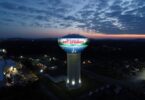Exclusive interview: H2O Global News Editor Sion Geschwindt spoke to BuntPlanet CEO and co-founder Ainhoa Lete, about non-revenue water and how emerging smart technologies are helping utilities combat the problem.
From source to treatment to tap – a lot of energy, time, and expense goes into supplying the water that flows from our taps.
And in a world confronted with challenges such as population growth and climate change – every drop really does count.
But shockingly, approximately 30% of all the water that is produced is lost before ever reaching the consumer.
This wastage is known as non-revenue water (NRW) and it’s a really big issue.
Water waste
NRW can occur through physical losses from leaking and broken pipes as well as commercial losses caused by the under-registration of customer meters, data handling errors, illegal connections and theft.
High levels of NRW reflect huge volumes of water being lost, not being invoiced to customers, or both.
Not only is NRW a waste of precious freshwater, it seriously affects the financial viability of water utilities through lost revenues and increased operational costs.
A World Bank study published in 2006, estimated that, globally, water utilities incurred losses in excess of USD 14 billion per year as a result of NRW.
However, a more recent study by the International Water Association (IWA) puts this figure at a whopping USD 39 billion per year. That is 346 million cubic metres per day.
If the world’s volume of non-revenue water was slashed by a third, the savings would be enough to supply 800 million people.
Authors of the study, Roland Liemberger (who also co-authored the 2006 paper) and Alan Wyatt emphasised that, “not only is this an enormous financial concern, but elevated NRW also detracts from water utilities, in a time of increasing scarcity and climate change, from reaching their goals of full service coverage at a reliable price.”
The researchers go on to highlight that if the world’s volume of NRW was slashed by a third, the savings would be sufficient to supply 800 million people.
Clearly NRW is a big problem that requires some pretty urgent solutions. But how exactly can utilities go about reducing NRW?
Ways forward
Most utilities know it is more cost-effective and sustainable to increase the efficiency of their networks than the volume of water that enters them.
The first port of call toward maximising efficiency is addressing physical leakage.
Leakage recovery is the best new water resource and technologies like noise loggers can help by quickly detecting leaks in the network.
However, prevention is the best cure, and leak detection is no replacement for rehabilitating and replacing ageing infrastructures. Pipe cleaning and relining, network replacement, service replacement, and valve and hydrant maintenance are all ways to keep water losses down.
But what about commercial losses?
Making sure that water meters are properly installed and maintained, and that they are accurately gathering and transferring data on water consumption, is essential if utilities are to close the gap between the water bill and actual usage. Tackling illegal consumption through mechanisms like routine inspections and prepay schemes is also crucial.
All these solutions, while necessary, are difficult and costly to implement and its hard for utilities to know where to start.
Thankfully, there are smart technologies available today don’t just alert utilities to the presence of a leak, but to those parts of the network that are most likely to fail in the future – saving time, finances and precious water supplies.
A smart approach
“The goal of water utilities around the world, independently of their regulatory framework or level of digitalisation, is to improve operational efficiency and reduce water losses,” said BuntPlanet CEO and co-founder Ainhoa Lete.
BuntPlanet is a Spanish company pioneering a smart approach to reducing NRW for utilities. Their software solution, BuntBrain, enables water utilities to detect and pre-locate leaks and other anomalies as soon as they appear.
BuntBrain receives real-time flow and consumption data information collected from IoT sensors in a utilities network, makes an analysis and identifies pipes with a greater probability of leakage. The solution also identifies water meters that should be checked or replaced if causing commercial losses.
“We are able to create a virtual ‘digital twin’ of a whole metering area,” Lete continues. “We use AI to optimise the number and location of the sensors, in order to achieve the greatest return on investment for water utilities.”
Through solutions like BuntBrain, utilities don’t have to be left in the dark waiting for the next leak to occur. They can proactively and accurately assess leakage risks and stay one step ahead.
“Some of our customers have been able to reduce their water losses levels by as much as 50%,” said Lete.
She concluded: “Water distribution networks are key components of our infrastructure and are essential to the security of our water supply. So identifying problems early, with the help of data analytics, should be high on the agenda of every government.”
Do you have an article or video that you would like to share? Submit your article here or keep up with the latest news from the water industry and wastewater industry by subscribing to our weekly newsletter







